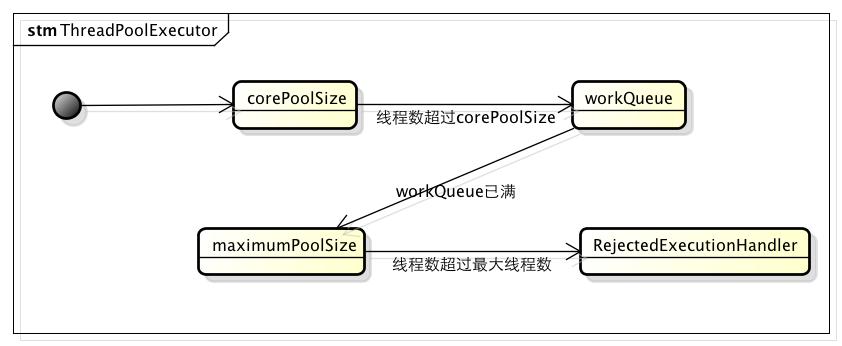ThreadPoolExecutor机制
Posted 阳光石头
tags:
篇首语:本文由小常识网(cha138.com)小编为大家整理,主要介绍了ThreadPoolExecutor机制相关的知识,希望对你有一定的参考价值。
一、概述1、ThreadPoolExecutor作为java.util.concurrent包对外提供基础实现,以内部线程池的形式对外提供管理任务执行,线程调度,线程池管理等等服务;
2、Executors方法提供的线程服务,都是通过参数设置来实现不同的线程池机制。
3、先来了解其线程池管理的机制,有助于正确使用,避免错误使用导致严重故障。同时可以根据自己的需求实现自己的线程池
二、核心构造方法讲解
下面是ThreadPoolExecutor最核心的构造方法
Java代码

- public ThreadPoolExecutor(int corePoolSize,
- int maximumPoolSize,
- long keepAliveTime,
- TimeUnit unit,
- BlockingQueue<Runnable> workQueue,
- ThreadFactory threadFactory,
- RejectedExecutionHandler handler)
- if (corePoolSize < 0 ||
- maximumPoolSize <= 0 ||
- maximumPoolSize < corePoolSize ||
- keepAliveTime < 0)
- throw new IllegalArgumentException();
- if (workQueue == null || threadFactory == null || handler == null)
- throw new NullPointerException();
- this.corePoolSize = corePoolSize;
- this.maximumPoolSize = maximumPoolSize;
- this.workQueue = workQueue;
- this.keepAliveTime = unit.toNanos(keepAliveTime);
- this.threadFactory = threadFactory;
- this.handler = handler;
构造方法参数讲解
| 参数名 | 作用 |
| corePoolSize | 核心线程池大小 |
| maximumPoolSize | 最大线程池大小 |
| keepAliveTime | 线程池中超过corePoolSize数目的空闲线程最大存活时间;可以allowCoreThreadTimeOut(true)使得核心线程有效时间 |
| TimeUnit | keepAliveTime时间单位 |
| workQueue | 阻塞任务队列 |
| threadFactory | 新建线程工厂 |
| RejectedExecutionHandler | 当提交任务数超过maxmumPoolSize+workQueue之和时,任务会交给RejectedExecutionHandler来处理 |
重点讲解:
其中比较容易让人误解的是:corePoolSize,maximumPoolSize,workQueue之间关系。
1.当线程池小于corePoolSize时,新提交任务将创建一个新线程执行任务,即使此时线程池中存在空闲线程。
2.当线程池达到corePoolSize时,新提交任务将被放入workQueue中,等待线程池中任务调度执行
3.当workQueue已满,且maximumPoolSize>corePoolSize时,新提交任务会创建新线程执行任务
4.当提交任务数超过maximumPoolSize时,新提交任务由RejectedExecutionHandler处理
5.当线程池中超过corePoolSize线程,空闲时间达到keepAliveTime时,关闭空闲线程
6.当设置allowCoreThreadTimeOut(true)时,线程池中corePoolSize线程空闲时间达到keepAliveTime也将关闭
线程管理机制图示:

三、Executors提供的线程池配置方案
1、构造一个固定线程数目的线程池,配置的corePoolSize与maximumPoolSize大小相同,同时使用了一个无界LinkedBlockingQueue存放阻塞任务,因此多余的任务将存在再阻塞队列,不会由RejectedExecutionHandler处理
Java代码

- public static ExecutorService newFixedThreadPool(int nThreads)
- return new ThreadPoolExecutor(nThreads, nThreads,
- 0L, TimeUnit.MILLISECONDS,
- new LinkedBlockingQueue<Runnable>());
2、构造一个缓冲功能的线程池,配置corePoolSize=0,maximumPoolSize=Integer.MAX_VALUE,keepAliveTime=60s,以及一个无容量的阻塞队列 SynchronousQueue,因此任务提交之后,将会创建新的线程执行;线程空闲超过60s将会销毁
Java代码

- public static ExecutorService newCachedThreadPool()
- return new ThreadPoolExecutor(0, Integer.MAX_VALUE,
- 60L, TimeUnit.SECONDS,
- new SynchronousQueue<Runnable>());
3、构造一个只支持一个线程的线程池,配置corePoolSize=maximumPoolSize=1,无界阻塞队列LinkedBlockingQueue;保证任务由一个线程串行执行
Java代码

- public static ExecutorService newSingleThreadExecutor()
- return new FinalizableDelegatedExecutorService
- (new ThreadPoolExecutor(1, 1,
- 0L, TimeUnit.MILLISECONDS,
- new LinkedBlockingQueue<Runnable>()));
4、构造有定时功能的线程池,配置corePoolSize,无界延迟阻塞队列DelayedWorkQueue;有意思的是:maximumPoolSize=Integer.MAX_VALUE,由于DelayedWorkQueue是无界队列,所以这个值是没有意义的
Java代码

- public static ScheduledExecutorService newScheduledThreadPool(int corePoolSize)
- return new ScheduledThreadPoolExecutor(corePoolSize);
- public static ScheduledExecutorService newScheduledThreadPool(
- int corePoolSize, ThreadFactory threadFactory)
- return new ScheduledThreadPoolExecutor(corePoolSize, threadFactory);
- public ScheduledThreadPoolExecutor(int corePoolSize,
- ThreadFactory threadFactory)
- super(corePoolSize, Integer.MAX_VALUE, 0, TimeUnit.NANOSECONDS,
- new DelayedWorkQueue(), threadFactory);
四、定制属于自己的非阻塞线程池
Java代码

- import java.util.concurrent.ArrayBlockingQueue;
- import java.util.concurrent.ExecutorService;
- import java.util.concurrent.RejectedExecutionHandler;
- import java.util.concurrent.ThreadFactory;
- import java.util.concurrent.ThreadPoolExecutor;
- import java.util.concurrent.TimeUnit;
- import java.util.concurrent.atomic.AtomicInteger;
- public class CustomThreadPoolExecutor
- private ThreadPoolExecutor pool = null;
- /**
- * 线程池初始化方法
- *
- * corePoolSize 核心线程池大小----10
- * maximumPoolSize 最大线程池大小----30
- * keepAliveTime 线程池中超过corePoolSize数目的空闲线程最大存活时间----30+单位TimeUnit
- * TimeUnit keepAliveTime时间单位----TimeUnit.MINUTES
- * workQueue 阻塞队列----new ArrayBlockingQueue<Runnable>(10)====10容量的阻塞队列
- * threadFactory 新建线程工厂----new CustomThreadFactory()====定制的线程工厂
- * rejectedExecutionHandler 当提交任务数超过maxmumPoolSize+workQueue之和时,
- * 即当提交第41个任务时(前面线程都没有执行完,此测试方法中用sleep(100)),
- * 任务会交给RejectedExecutionHandler来处理
- */
- public void init()
- pool = new ThreadPoolExecutor(
- 10,
- 30,
- 30,
- TimeUnit.MINUTES,
- new ArrayBlockingQueue<Runnable>(10),
- new CustomThreadFactory(),
- new CustomRejectedExecutionHandler());
- public void destory()
- if(pool != null)
- pool.shutdownNow();
- public ExecutorService getCustomThreadPoolExecutor()
- return this.pool;
- private class CustomThreadFactory implements ThreadFactory
- private AtomicInteger count = new AtomicInteger(0);
- @Override
- public Thread newThread(Runnable r)
- Thread t = new Thread(r);
- String threadName = CustomThreadPoolExecutor.class.getSimpleName() + count.addAndGet(1);
- System.out.println(threadName);
- t.setName(threadName);
- return t;
- private class CustomRejectedExecutionHandler implements RejectedExecutionHandler
- @Override
- public void rejectedExecution(Runnable r, ThreadPoolExecutor executor)
- // 记录异常
- // 报警处理等
- System.out.println("error.............");
- // 测试构造的线程池
- public static void main(String[] args)
- CustomThreadPoolExecutor exec = new CustomThreadPoolExecutor();
- // 1.初始化
- exec.init();
- ExecutorService pool = exec.getCustomThreadPoolExecutor();
- for(int i=1; i<100; i++)
- System.out.println("提交第" + i + "个任务!");
- pool.execute(new Runnable()
- @Override
- public void run()
- try
- Thread.sleep(3000);
- catch (InterruptedException e)
- e.printStackTrace();
- System.out.println("running=====");
- );
- // 2.销毁----此处不能销毁,因为任务没有提交执行完,如果销毁线程池,任务也就无法执行了
- // exec.destory();